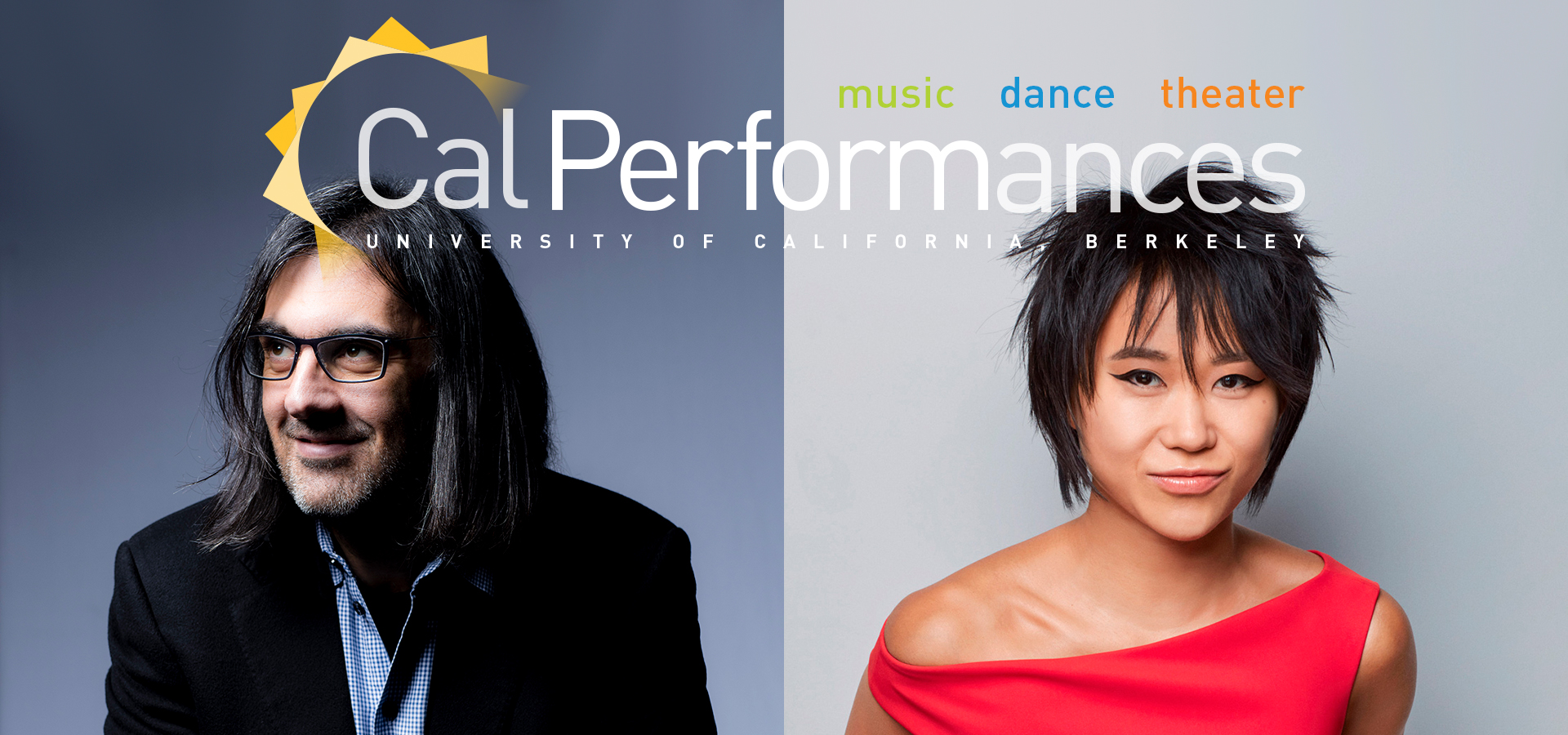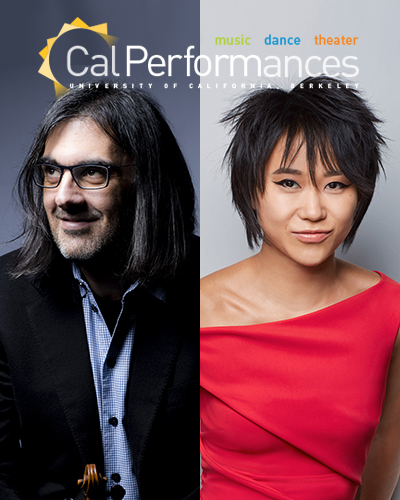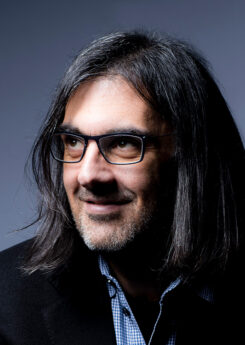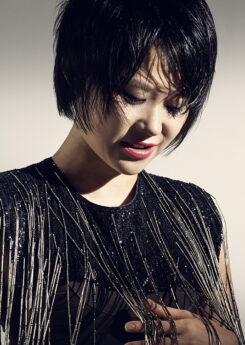Leonidas Kavakos, violin and Yuja Wang, piano
Nov 13, 2021
Zellerbach Hall
This performance is made possible, in part, by Patron Sponsor Nadine Tang.
From the Executive and Artistic Director

We’ve now moved into the heart of Fall Semester and things are hopping on the UC Berkeley campus. The same can be said about Cal Performances, where—this weekend alone—we’ll enjoy concerts by an array of world-class musical talent: mandolinist Avi Avital and guitarist Miloš (Nov 11), American jazz master Aaron Diehl and his trio (Nov 12), violinist Leonidas Kavakos and pianist Yuja Wang (Nov 13), and cellist David Finckel and pianist Wu Han (Nov 14). Together, we’ll take in music by Bach, de Falla, Villa Lobos, and Philip Glass; experience a world premiere by French composer Mathias Duplessy; return to Bach to explore his fascinating musical ties with eminent jazz musicians past and present; and close out the weekend with more timeless music by Bach (there’s never enough!) along with works by Busoni, Shostakovich, Mendelssohn, Debussy, and Britten. I’m so happy you could join us during what promises to be a memorable weekend; it’s wonderful that we can gather together again, enjoying great music under the same roof!
This robust activity is especially meaningful this year, following such a prolonged period of shutdown! When the pandemic forced Cal Performances to close its doors in March 2020, no one could have imagined what lay ahead. Since then, we’ve witnessed a worldwide health crisis unlike any experienced during our lifetimes, an extended period of political turmoil, recurring incidents of civil unrest and racially motivated violence, and a consciousness-raising human rights movement that has forever—and significantly—changed how each of us views social justice in our time.
Of course, the pandemic remains with us to this date and future challenges—including many adjustments to “normal’ procedures and policies—can certainly be expected. I encourage you to check Cal Performances’ website regularly for the most current information regarding our COVID-19 response. First and foremost, I assure you that there is nothing more important to us than the health and safety of our audience, artists, and staff. (And I remind one and all that proof of vaccination is mandatory today, as is protective masking throughout the event.)
Our season continues in December when the Bay Area’s beloved Kronos Quartet returns to Zellerbach Hall with two-part program featuring a world premiere by Cal Performances’ 2021–22 artist-in-residence Angélique Kidjo, new and recent works from Kronos’ extraordinary 50 for the Future project, and a selection of works performed with special guest, Persian classical and world music vocalist and composer, Mahsa Vahdat (Dec 2). Our full calendar offers more of the same, packed with the kind of adventurous and ambitious programming you’ve come to expect from Cal Performances. In particular, I want to direct your attention to this year’s Illuminations: “Place and Displacement” programming, through which we’ll explore both loss and renewal, disempowerment and hope, while seeking paths forward for reclaiming and celebrating vital cultural connections that can fall victim to political and social upheaval.
Please take the opportunity to explore the complete schedule through our website and season brochure and begin planning your performance calendar; now is the perfect time to guarantee that you have the best seats for all the events you plan to attend.
Throughout history, the performing arts have survived incredible challenges: periods of war, economic collapse, and, yes, terrible disease. And if it will take time for us—collectively and individually—to process the events of the past 18 months, I’m certain that the arts have the power to play a critical role as we come to terms with what we have experienced and move together toward recovery.
I know you join us in looking forward to what lies ahead, to coming together once again to encounter the life-changing experiences that only the live performing arts deliver. We can’t wait to share it all with you during the coming year.
Cal Performances is back. Welcome home!
Jeremy Geffen
Executive and Artistic Director, Cal Performances

We’ve now moved into the heart of Fall Semester and things are hopping on the UC Berkeley campus. The same can be said about Cal Performances, where—this weekend alone—we’ll enjoy concerts by an array of world-class musical talent: mandolinist Avi Avital and guitarist Miloš (Nov 11), American jazz master Aaron Diehl and his trio (Nov 12), violinist Leonidas Kavakos and pianist Yuja Wang (Nov 13), and cellist David Finckel and pianist Wu Han (Nov 14). Together, we’ll take in music by Bach, de Falla, Villa Lobos, and Philip Glass; experience a world premiere by French composer Mathias Duplessy; return to Bach to explore his fascinating musical ties with eminent jazz musicians past and present; and close out the weekend with more timeless music by Bach (there’s never enough!) along with works by Busoni, Shostakovich, Mendelssohn, Debussy, and Britten. I’m so happy you could join us during what promises to be a memorable weekend; it’s wonderful that we can gather together again, enjoying great music under the same roof!
This robust activity is especially meaningful this year, following such a prolonged period of shutdown! When the pandemic forced Cal Performances to close its doors in March 2020, no one could have imagined what lay ahead. Since then, we’ve witnessed a worldwide health crisis unlike any experienced during our lifetimes, an extended period of political turmoil, recurring incidents of civil unrest and racially motivated violence, and a consciousness-raising human rights movement that has forever—and significantly—changed how each of us views social justice in our time.
Of course, the pandemic remains with us to this date and future challenges—including many adjustments to “normal’ procedures and policies—can certainly be expected. I encourage you to check Cal Performances’ website regularly for the most current information regarding our COVID-19 response. First and foremost, I assure you that there is nothing more important to us than the health and safety of our audience, artists, and staff. (And I remind one and all that proof of vaccination is mandatory today, as is protective masking throughout the event.)
Our season continues in December when the Bay Area’s beloved Kronos Quartet returns to Zellerbach Hall with two-part program featuring a world premiere by Cal Performances’ 2021–22 artist-in-residence Angélique Kidjo, new and recent works from Kronos’ extraordinary 50 for the Future project, and a selection of works performed with special guest, Persian classical and world music vocalist and composer, Mahsa Vahdat (Dec 2). Our full calendar offers more of the same, packed with the kind of adventurous and ambitious programming you’ve come to expect from Cal Performances. In particular, I want to direct your attention to this year’s Illuminations: “Place and Displacement” programming, through which we’ll explore both loss and renewal, disempowerment and hope, while seeking paths forward for reclaiming and celebrating vital cultural connections that can fall victim to political and social upheaval.
Please take the opportunity to explore the complete schedule through our website and season brochure and begin planning your performance calendar; now is the perfect time to guarantee that you have the best seats for all the events you plan to attend.
Throughout history, the performing arts have survived incredible challenges: periods of war, economic collapse, and, yes, terrible disease. And if it will take time for us—collectively and individually—to process the events of the past 18 months, I’m certain that the arts have the power to play a critical role as we come to terms with what we have experienced and move together toward recovery.
I know you join us in looking forward to what lies ahead, to coming together once again to encounter the life-changing experiences that only the live performing arts deliver. We can’t wait to share it all with you during the coming year.
Cal Performances is back. Welcome home!
Jeremy Geffen
Executive and Artistic Director, Cal Performances
About the Program
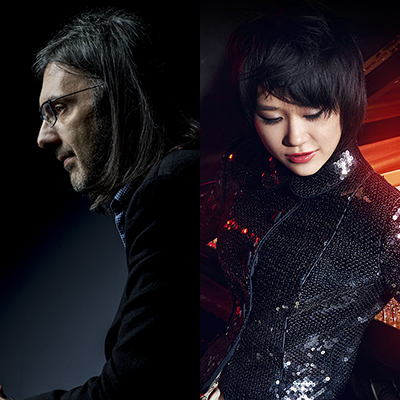 A Very Special Duo: Yuja Wang and Leonidas Kavakos Play Bach, Busoni, and Shostakovich
A Very Special Duo: Yuja Wang and Leonidas Kavakos Play Bach, Busoni, and Shostakovich
The ongoing collaboration between Yuja Wang and Leonidas Kavakos represents a welcome rarity in today’s classical scene. Each is a superstar virtuoso of the piano and violin, respectively, and each brings to the partnership a highly distinctive aesthetic—underscored by a difference in age of two decades. Yet the pair’s chemistry enables them to blend powerfully individual personalities across a remarkably diverse musical spectrum.
This evening’s program, for example, juxtaposes the early foundations of the violin sonata established by Johann Sebastian Bach with ambitious essays in the genre by composers as far apart as Ferruccio Busoni and Dmitri Shostakovich. The first is a seldom performed, fin-de-siècle work from early in Busoni’s career, while the Russian composer’s sole violin sonata dates from his final decade. Both sonatas nevertheless share the influence of Bach’s legacy.
As performers, all three composers were themselves virtuosos of the keyboard. The history of the accompanied violin sonata may be traced from the perspective of the relationship between the piano or (in Bach’s case) harpsichord and the violin. Vastly different as these instruments are in terms of sound production and character, Bach, Busoni, and Shostakovich explore the musical potential of their partnership in fascinating ways.
Johann Sebastian Bach
Sonata No. 3 for Violin and Keyboard
in E major, BWV 1016
The earliest extant source for the six sonatas for violin and keyboard (BWV 1014–1019) dates from 1725; it is a copy written by the composer’s nephew Johann Heinrich Bach, with additions in the hand of Johann Sebastian. We lack an autograph manuscript as well as an authentic title: the copy is headed “Sei Sounate â Cembalo [con]certato è Violino Solo,” meaning six sonatas for obbligato harpsichord and solo violin. By then, J.S. Bach was settled into the final, longest station of his career in Leipzig, serving as music director of the city’s principal churches.
But many commentators assume these works were the products of the period immediately preceding Leipzig, when Bach was employed from 1717 to 1723 as Kappellmeister to Prince Leopold in Cöthen (about 33 miles northwest of Leipzig). Because of Leopold’s Calvinist persuasion, music was not a main part of the worship services and Bach was instead at liberty to focus on secular composition. The fruits of this period thus include such masterpieces as the sonatas and partitas for solo violin, the suites for solo cello, the first book of the Well-Tempered Clavier, and the Brandenburg Concertos.
Even so, Bach did write some important instrumental works apart from his liturgical responsibilities during the later Leipzig years—mostly for the secular Collegium Musicum, which attracted university students—and it is known that he continued to make revisions to the six accompanied violin sonatas until late in his life. In his recent book Bach’s Musical Universe, the eminent scholar Christoph Wolff even asserts that these sonatas “originated in the earlier Leipzig years” (presumably, between 1723 and 1725).
In any case, these works offered Bach a vehicle for experimenting with Baroque concepts of the ensemble sonata and anticipate the emergence of the modern accompanied sonata. His formal compositional precedent was the so-called trio sonata—a term used for pieces featuring a pair of solo or “melody” instruments with basso continuo accompaniment, hence with three parts.
Bach’s innovation in these sonatas was to expand the harpsichord beyond its identity as mere continuo accompaniment to, say, a pair of violins. Instead, Bach assigns an independent role to the treble register equivalent to that of the other solo instrument in a conventional trio sonata, while the harpsichord continues to provide the expected bass line. In other words: the harpsichord/piano fuses the two identities of melody instrument and partner to the violin with basso continuo. The 1725 manuscript of BWV 1014–1019 even refers to the possibility of doubling this bass line function with an optional viola da gamba. But Bach’s transformation of the Baroque trio sonata practice into a “duo sonata” was remarkably innovative, making that earlier precedent obsolete.
At the same time, Bach—in five of the six sonatas—preserves the conventional pattern of the Corellian “church sonata” (sonata da chiesa) from the 17th century, with its architecture of two pairs of slow and fast movements. Thus the E major Sonata begins with an Adagio whose melodic blossoming indeed evokes the ravishing expressiveness of Arcangelo Corelli. This leads into a fugal Allegro, the varying instrumental timbres adding a special note of cheerful clarity to the counterpoint. The ensuing Adagio ma non tango in C-sharp minor, in which Bach unfolds a solemn, affecting passacaglia, is a high point of the accompanied violin sonatas.The high-energy Allegro finale calls for virtuosity from the violin and keyboard alike as both exchange rapid-fire 16th notes and triplets.
Feruccio Busoni
Sonata No. 2 for Violin and Piano
in E minor, Op. 36a
Ferruccio Busoni, the son of German-Italian parents who were both serious musicians, can sound like a Thomas Mann character come to life. Throughout his career, he attempted to synthesize both strands: the contrapuntal complexity of J.S. Bach with a Mediterranean grace of form, the stern discipline of the North with the fantasy and omnivorous curiosity of Leonardo Da Vinci (like Bach, one of his key inspirations). He also sought to balance his double identity as a composer-performer. Busoni gained international fame as a child prodigy and subsequently as one of the leading piano virtuosos in a golden age of pianism. But he considered himself first and foremost a composer. Busoni’s famous transcriptions of Bach for the piano—such as his version of the Chaconne in D minor from the Partita No. 2 for solo violin—in many ways bridge the gap.
This drive to combine seemingly disparate elements is already evident in the contrasting threads that comprise the Violin Sonata No. 2. It dates from the summer of 1898, when the 32-year-old, Berlin-based Busoni was expending much of his creative effort on piano concertizing—he became known as “a musical Ishmael”—and hence had little time for composition. Busoni revised the score in 1900, when he played the piano part at the world premiere in Helsinki, together with Viktor Novácek as the violinist. Novácek’s brother Ottokar, a close friend of Busoni, had died earlier that year, and the composer honored his memory by dedicating the Second Sonata to Ottokar.
The sonata essentially speaks the language of late Romanticism, but there are already hints of the unique voice Busoni was developing. Cast in three interconnected movements, the work culminates in a massive finale nearly twice as long as the first two combined. Beethoven’s late Piano Sonata in E major, Op. 109, served as a model for this striking architecture—above all in the use of theme-and-variations as a concluding apotheosis of what has come before.
The opening music, slow and poignantly meditative, is not in fact a preparation for the main movement proper but an important idea that returns later throughout the work. A faster tempo ushers in new, ecstatically restless material. The return of the opening meditation hints at the resolution to come after much striving. As in the Beethoven sonata, a tightly compressed, breakneck middle movement bridges the outer movements—here, in the guise of a self-conscious tarantella, both vital and self-aware.
Busoni introduces the final movement with a return to the searching mode of the opening. This yields to a quotation of the Bach chorale “Wie wohl ist mir, O Freund der Seelen” (“O Friend of souls, what blessings follow”), which appears near the end of the 1725 Notebook for Anna Magdalena Bach. The chorale, presented in a gently solemn statement (Busoni’s description), opens the door to a remarkable variety of treatments in the variations that follow. These range from an impish march to a soulful rumination in the minor and, finally, an impressive fugue. But instead of ending with a grand Baroque-Romantic climax, Busoni guides the music into an unexpected reconsideration of the opening idea from the first movement, now calm and serene. The Violin Sonata proved to be an important turning point for the composer, who regarded it as the first statement of his authentic voice.
J.S. Bach
Sonata No. 1 for Violin and Keyboard
in B minor, BWV 1014
The six violin-keyboard sonatas were especially prized within Bach’s family. Son Carl Philipp Emanuel wrote in a letter in 1774 that these works—he called them “clavier trios,” indicating the generic origin described above—“still sound very good now, and give me much pleasure, despite the fact that they are over 50 years old.” So much for the cliché that old Johann Sebastian was considered hopelessly outdated by his successors.
The opening Adagio of the B minor Sonata plays off the different sound qualities of the keyboard and the violin, first establishing the independence of the right and left hands in the keyboard part before the violin enters with expressively sustained notes. The slow movements of these sonatas in general, writes Christoph Wolff, “were from the outset the most modern settings within the group, and since every sonata contains two slow movements, they figure prominently within each individual work.” The fast movements, by contrast, are “stylistically less forward-looking” but continue to play with the contrapuntal potential unleashed by liberating the keyboard from its continuo function—as the ensuing Allegro makes clear.
Perhaps C.P.E. Bach had the beautiful Andante in mind when he wrote: “There are a few Adagios in [the six sonatas] that to this day are unexcelled in their cantabile qualities.” Father Johann Sebastian, it should be recalled, was not only a celebrated keyboard player but a skillful violinist who owned several string instruments. The final Allegro calls for virtuoso effects idiomatically suited to keyboard and violin alike.
Dmitri Shostakovich
Sonata for Violin and Piano in G major,
Op. 134
The music of Bach proved to be a creative refuge for Dmitri Shostakovich—especially during periods when he felt creatively attacked and stifled. After being hailed as a cultural hero for his morale-boosting music during the Second World War, Shostakovich was promptly humiliated by a public denunciation in 1948 (eerily echoing his first fall from grace over his runaway hit opera Lady Macbeth of Mtsensk in 1936). The Supreme Soviet accused a number of composers (Shostakovich and Prokofiev among them) of daring to introduce the “corrupt” influences of Western Modernism into their music.
Shostakovich was at the time working on his First Violin Concerto for the virtuoso David Oistrakh. He had first encountered Oistrakh’s playing in 1935, and the two later became friends. But when Shostakovich completed the score, he decided it was safer for the time being to withhold it from the public (much as he had done with his audacious Fourth Symphony following the condemnation of 1936). Celebrations of the bicentenary of Bach’s death in 1950 provided the impetus for a very different undertaking: the 24 Preludes and Fugues, Op. 87, his vast cycle for piano; it covers all the major and minor keys and is loaded with allusions to his predecessor’s Well-Tempered Clavier.
Following the death of Stalin in 1953, Shostakovich experienced further cycles of rehabilitation and reactionary compromise. The concerto for Oistrakh was finally unveiled in 1955 to great success; in 1967, he proceeded to write a second concerto for the acclaimed violinist (the last of his six concertos). With the Op. 134 Violin Sonata, according to some commentators, the composer intended to honor a milestone birthday but made an embarrassing date miscalculation.
The biographer Laurel Fay, however, writes that Oistrakh “came to believe somehow that Shostakovich had intended the Second Concerto as a present for his 60th birthday but had mistakenly bestowed the gift a year early. Perhaps there was some misunderstanding. This was not the kind of error the punctilious Shostakovich was prone to; in his communications with the violinist concerning the Second Concerto the anniversary is not mentioned.”
In any case, Shostakovich clearly intended to present the Violin Sonata wrapped up as a 60th-birthday present and began composing it in August 1968; he turned out to be late by a few weeks, completing the score in late October. Oistrakh was joined by another giant among Soviet musicians of the time, the pianist Sviatoslav Richter, for the official public premiere, which took place in Moscow on May 3, 1969. (A recording exists of Oistrakh playing the piece with Shostakovich at the keyboard in the composer’s apartment, though he had been compelled to stop performing in public as a pianist in 1966, when he suffered his first heart attack.)
Shostakovich dedicated not only the two violin concertos to Oistrakh but the Violin Sonata as well—one of three sonatas he wrote featuring string instruments. (He had begun work on an earlier violin sonata in 1945 but dropped it after the first movement.) The other two are, respectively, for cello (Op. 40, an early work from 1934) and viola (Op. 147 from 1975, his last completed composition). The Violin Sonata is thus of late vintage; its epic scale spans more than a half hour, combining inspiration from the Baroque with a newfound interest in the expressive potential of twelve-tone music (while still rejecting the systematic use of such material by Schoenberg & Co.).
The austere opening Andante begins with chromatic octaves on the piano (covering all 12 notes); it rises in register and then falls as the violin adds its voice, inscribing the composer’s initials into its chromatic theme. Tension emerges in the divergent planes each instrument seems intent on following. Each trades its version of the sardonic second theme, for which the vague meter of the opening becomes more march-like. Shostakovich makes effective use of pauses and unusual textures, calling for macabre sul ponticello brushings on the violin later in the movement. Curiously, at an early point in the composition he referred to this movement as “pastoral,” but it evokes the tragic intensity of a Bach Passion.
The tensely, even terrifyingly, energetic middle movement, at times brutal in its gestures, plays the role of a scherzo with shadings of klezmer. It bristles with irony as it introduces more metric “normalcy” in the guise of a waltz. The final movement is the longest, beginning with a powerful, slow statement of brusque dotted rhythms shared between piano and violin. This has the character of an unyielding passacaglia pattern—a sequence, usually confined to the bass, over which variations unfold. Shostakovich returned to this Baroque form in several works, especially in his later years, including with this capstone to the Violin Sonata.
The actual theme is then spelled out first not in the bass but on the violin, which plays it pizzicato. A series of variations, wildly different in character, follow until first the piano, then the violin are each given solo cadenzas, joining again in a restatement of the introductory passage. Shostakovich then reprises music from the first movement, bringing the sonata to an uneasy, enigmatic, funereal rest with more sul ponticello tremblings.


